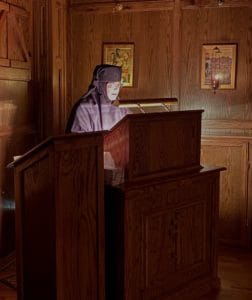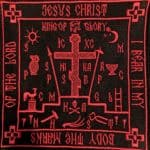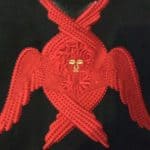Monastic Life
Monasteries exist as pockets of Paradise “in the world but not of the world.” [1] Sometimes, many choose to think about monastics as those who are denying themselves the offerings of the world. While this is true, and possibly a greater struggle in the beginning, the true emphasis of monastic life should be placed on running toward God. To quote Saint Benedict, “What can be sweeter to us than this voice of the Lord inviting us?”[2] As time passes, the chasm between what is worldly widens and deepens. Gradually, the monastic understands and completely rejects the detriment of materialism, narcissism and the malaise of sin that was left behind, but she also enjoys the riches that surround and entice her to seek for the Beloved at all hours, in Church, in her cell or at work. There is nothing more important, nothing that provides life and the very breath she needs to be alive in Christ.
In the Orthodox Church, there are no monastic “orders” for all is contained in the whole expression of monasticism. There are no “cloisters,” but every monastery has places where guests are not permitted. Like families, monastic houses will differ by the composition of the people and their way of life or typicon, a rule that outlines their schedule and life. Some monasteries may work inside their monastic campus making a product or providing retreats, while others may have a school, an orphanage, or some other ministry.
Types of Monasticism
Most monasteries are coenobitic, meaning that they live, pray, work, and eat in common. This type of life was recorded by Saint Pachomius in southern Egypt and also followed by Saint Basil in Cappadocia, both in the early 4th Century. If you have read about the desert Fathers or Mothers, then you are acquainted with eremitical monasticism, the life of hermits. We have a full account of the life of Saint Antony the Great, who was a hermit monk around 285 AD, written by Saint Athanasius. Although harder to find, especially amongst female Orthodox monasteries, there are monastics who seek to be semi-eremitical as was Abba Amoun in the beginning of the 4th Century. In the late 5th Century, 70 hermits joined around Saint Savvas’ cave in the Kidron Valley. As the colony of hermit monks grew to 150, the Saint chose a central cave to be the Church and the heart of their Lavra.[3] Saint Savvas’ recording of the worship cycle and the practices of his community are known as the Typicon of St Savvas or the Jerusalem Typicon.


Holy Resurrection Monastery
Holy Resurrection Monastery follows a semi-eremitical rule of life, meaning a life of prayer that is at times communal in Chapel (Matins, Vespers, Divine Liturgy), the daily meal or activities and most of the time eremitical at work or prayer in the nun’s cell. There is one common meal a day, but other meals are eaten alone. Currently, Thursdays are quiet, hermit days when there is no loud activity, no guests and the focus is reading, reflection, and prayer. Semi-eremitical monastic life is a meeting of solitude in community and personal solitude.
From the Monastery's Typicon
“The word monastic comes from monos and signifies being “alone with God.” This is the most common reason for entry into the monastic life and we learn of its depths with time and struggle. Communal solitude sets the stage for personal solitude. As monastics, we live in a monastery that is a collection of cells. The strength of the collection is dependent on the strength of the cells. Think of a beehive in which all of the bees, who are predominately female – sometimes alone and at other times in a group – work to build and arrange the cells from their own bodies, feed and nurture the young, care and clean other workers, care for their superior, gather and store supplies, and care for the dead. A healthy and growing knowledge and understanding of ourselves, expressed in repentance and desire for God’s loving mercy, can be compared to the sticky propolis in a beehive that is used for construction, blocking out ill wind, repairing what is broken, and promoting healing.
When a monastic is spiritually healthy, she is a strong cell. This occurs over time with silence, solitude, cell rule, prayer at work, immersion in the Holy Scriptures and Services, spiritual reading of the Fathers and Mothers of the Church, etc. In the world, we resisted the pull of the world, and without that distraction in the monastery, we resist the pull towards idle chat, vain pursuits, acquisitiveness, and the passions. Before entry into monastic life, we decreased our involvement in activities that took us away from pursuit of our heart’s desire. Now, immersed in the monastic life, we decrease ourselves. “He must increase, and I must decrease.”” [4] [5]






References
[1] Jn 17.14-19
[2] Rule of St Benedict, Prologue.
[3] A lavra or laura (Greek: Λαύρα; Cyrillic: Ла́вра) is a type of monastery consisting of a cluster of cells or caves for hermits, with a church and sometimes a refectory at the center.” Wikipedia
[4] The Typicon of Holy Resurrection Monastery, §51, Niangua, MO, 2020.
[5] Jn 3.30
[6] Ps 94.7-8
[7] Jn 1.46
